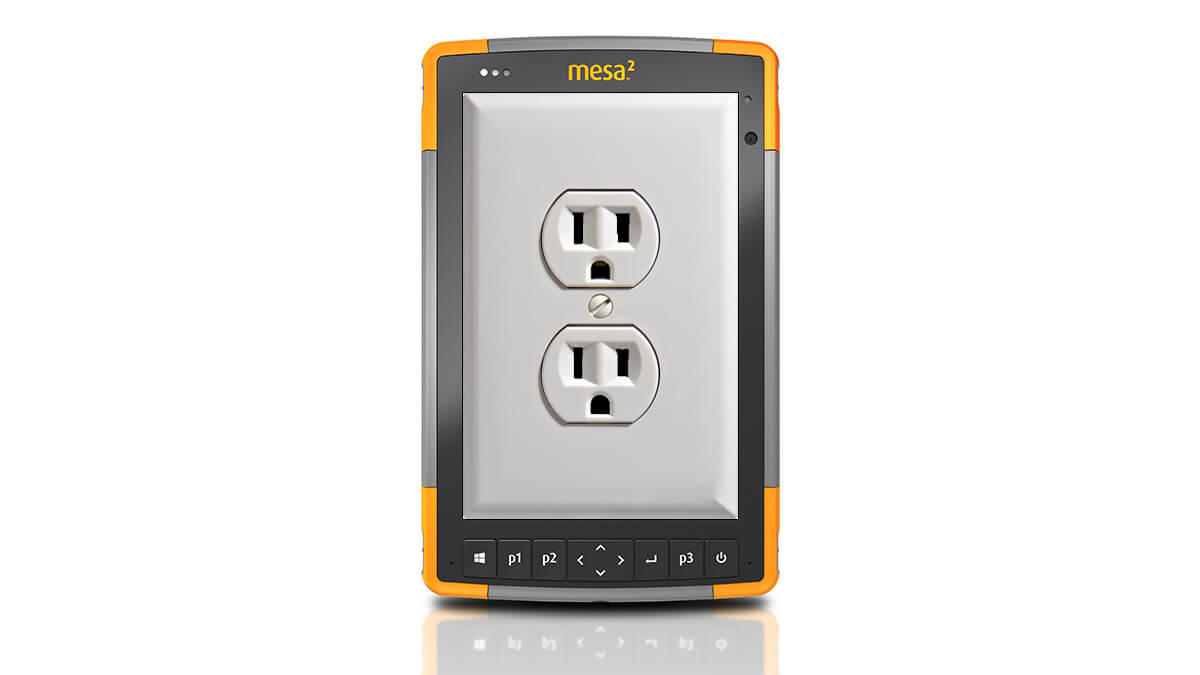 Powering an external device with a rugged handheld
Powering an external device with a rugged handheld
Juniper Systems’ lineup of rugged mobile computers and tablets, packed with battery power, have enough energy to spare. The work-all-day battery capacity inside Juniper Systems products is designed to share power with external accessories like a barcode scan gun, RFID reader, data acquisition adapter, or CAC card reader.
“Sometimes external devices need a stream of energy,” Juniper Systems product manager Slade Gurr said. “We designed our products with energy to share.”
The USB host port can provide 5 volts of regulated power at 600 milliampere, which is enough to power a host of external devices. The RS-232 serial communication port, featured on the Allegro 2, Archer 2, and optionally on the Mesa 2, can provide 5 volts or 12 volts to power devices. Older Juniper Systems products like the Allegro Field PC and Archer Field PC can supply 5 volts through their USB ports and card slots.
[ilink url=”http://www.junipersys.com/Juniper-Systems-Rugged-Handheld-Computers/support/Knowledge-Base/Support-Knowledge-Base-Topics/Accessories/Power-Devices-through-Ports-or-Card-Slots”]Power devices through ports or card slots[/ilink]
The Mesa 2, Allegro 2, and Archer 2 boast a 12,000 mAh battery, which is more than four times the size of the iPhone X battery, and 1,000 mAh more energy capacity than the iPad Pro 2 battery. Milliampere hour, or mAh, is a common measure of energy capacity – a larger number indicates a battery with more energy capacity.
Interest in portable battery chargers has risen steadily since 2010 when global sales reached $10 billion. Since 2010, the global market has more than doubled, driven by the increased adoption of portable electronic devices, to $21 billion, according to research published on Statista, an online statistics aggregator.
Developers can tap into Juniper Systems’ battery capacity, too.
“Developers can attach and power devices through docking pins or work with us to integrate other devices,” product support manager O’Ryan Smith said. “Our customers already use the ports to power UHF RFID scanners, fluid monitoring and quality measurement sensors, GPS receivers, and more.”
[ilink url=”http://blog.junipersys.com/4-things-you-should-know-about-uhf-rfid-before-testing/”]4 things you should know before testing UHF RFID[/ilink]
“Juniper Systems partners have also worked with us to attach or integrate digital voltmeters, specialized RFID readers, and various custom radios,” he added.
Extending rugged handheld battery life
The recipe for non-stop, 24/7 operation of Juniper Systems’ rugged handhelds calls for a 12-volt car battery.
Really.
Attaching one of Juniper Systems’ devices to a 12-volt portable car jump battery or any other 12-volt battery allows your rugged mobile computer or tablet to run indefinitely. You should be careful not to start or stop the portable battery’s power supply when a device is attached – it could potentially damage the connected device. Otherwise, many of Juniper Systems’ devices contain swappable battery capability or optional hot-swappable battery capable, a system that allows for an uninterrupted battery swap.
“Some field professionals have attached their device directly to the positive and negative terminals of a car battery,” O’Ryan said. “They run the device for days using their car in the field.”
If these options aren’t available, you can extend the life of a device by switching off battery-draining applications and features.
External power bank
How to save power on a rugged handheld
- Turn off Bluetooth®
- Close unnecessary applications
- Turn off keypad backlight
- Turn off the display backlight
- Turn off serial devices and continuous serial communication
- Turn off any radio connectivity like Wi-Fi, cellular connection, and custom radio modems
Charging a rugged handheld in the field
Juniper Systems rugged mobile computers and tablets are field-ready in a number of ways – including the ways in which you can charge them.
While the standard 12-volt wall charger included with each Juniper Systems rugged mobile computer or tablet should fully charge a battery within two to four hours. A vehicle charger with charging adapter, or any other 12-24 volt power source, could rapidly charge a device to two-thirds battery capacity within an hour.
“All-day batteries need to be charged, too,” O’Ryan said. “This option has helped field professionals finish their work despite their distance from a wall plug.”
An alternative charging option for fieldwork: the sun. An 18-watt solar panel with a traditional AC plug socket or a vehicle charger socket can charge an external battery or device during the day.
Solar panel chargers
For more information about Juniper Systems’ rugged mobile computers, tablets, and GNSS receivers, contact us here. Visit Juniper Systems online here.

